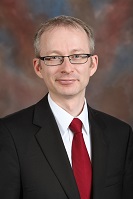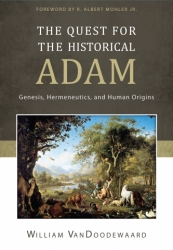Welcome again to Books At a Glance as we continue our brief discussions tracking out the Protestant Reformation of the sixteenth century. I’m Fred Zaspel, and today we are talking to Dr. William Vandoodewaard of Puritan Reformed Theological Seminary—our topic: the Dutch Reformation.
Bill, welcome! And thanks for talking to us.
Vandoodewaard:
It’s great to be here with you, Fred. Thank you for inviting me.
Zaspel:
Describe the medieval backgrounds to the Reformation in the Low Countries. And were there any pre-Reformation movements for Reformation?
Vandoodewaard:
The situation in the Low Countries in the medieval era, the late medieval period would be much like that across Europe. And so what we’re looking at is a dominant Roman Catholicism that in past centuries has seen the triple papacy, so the conciliar movement being there, frustration with evident corruption, nepotism in the life of the church, immorality. And yet, at the same time, you can say, in a sense, a very strong mentality of medieval Christendom. That this is Christian Europe, cathedrals dominating the landscape and churches, pilgrimages, ritual; all of this being the life of the public, just the general populace. So, a very religious society, and yet one in which the doctrines of grace are really scarcely known. Though there were some pre-Reformation movements that did have at least some understanding of the doctrines of grace. I’d be glad to share a few of those with you – just some of those key figures.
If we go back as early as the year 1106, before we have influence of the Waldensians into the Low Countries and the Lollards, at least with historical clarity and evidence, there is record of a popular preacher named Tanchelinus who rejected the doctrine of papal authority, preached from the Scriptures in Antwerp and nearby regions, and was vehemently opposed by a man named Norbert, a higher cleric in the church.
We move forward into the 1200s. In the same area, there was a man named William Cornelius who actually held to a more biblically grounded view of the sacrament of the Lord’s Supper which, it was said, he learned from the followers of this previous figure. And he was opposed to transubstantiation.
Then Nicholas of Lira writes a great commentary on the Bible, which is more Augustinian in its orientation. So we see these early threads already in the Low Countries.
Another significant movement that will develop in the Low Countries would be the Brethren of the Common Life and Thomas a Kempis, perhaps, a very well-known figure who would be influential as a member of this movement. But again, it was a movement that thought to return to the Scriptures, thought to educate, particularly young men in the Word. And the key founding figure, Gerhard Grote, who lived from 1340 to 1384, was banned from preaching by the Bishop of the Utrecht, and in response to that, set up schools. These schools, very interestingly, over time would produce a great number of the reformers in the Low Countries.
As we look at precursors to the Reformation in the low countries, you have sort of this Augustinian, Bible-oriented movement that exists. Then, of course, you also have the entrance of the Waldensians, the Lollards, the Hussites having influence into the Low Countries. So there is actually a surprising amount, you could say, of light in the darkness at a popular level, even though it’s suppressed and certainly doesn’t receive a warm welcome by the Roman Catholic hierarchy in the Low Countries.
Zaspel:
What was the cultural and political state of the Low Countries at the dawn of the Reformation?
Vandoodewaard:
They were, politically, a lesser power dominated by Spain, and yet important in terms of trade and commerce. They are situated at the confluence of the Rhine River and the North Sea, right by the English Channel, Atlantic Coast of Europe and so particularly Antwerp, but also some of the other coastal cities there, are very key trade cities. And so trade from Germany, further inland, will be flowing along the Rhine and through the rivers that come into the Low Countries. And you have those cities there that will be great merchant centers, trade centers, with England, Scotland, Ireland, going down the coast to Spain. Politically, they are not a powerhouse at this point, though that will increase through banking and merchant trade over time; but they are very significant as a place where you have people from all over Europe traveling there, doing business there with a lot of people and goods moving through. And with the Reformation, we will see a lot of ideas flowing through, as well.
Zaspel:
How did the Reformation begin and progress in the Low Countries?
Vandoodewaard:
Looking back at the medieval backgrounds, we do see that there’s a bit of an independent mindset there that goes back to the Middle Ages. Even the Bishop of Utrecht at various times was a strong critic of the papacy. We see the spirit of independence that’s there, but, because of the crossroads location, we do see Reformation stirrings taking place there very early on.
There are really three phases that take place. The first phase is the Lutheran phase of the Reformation. Within a year of Martin Luther nailing his 95 theses, those ideas attract attention throughout Germany. They are published in surrounding nations and are tremendously popular in the Low Countries. In the Low Countries, these trade cities like Antwerp are key publishing centers, as well. What we see is that publishers, printers, in Antwerp will print Luther’s works at their own expense. Some historians have noted or argued that it seems to be the pattern that Roman Catholics had their works printed at cost and the quality wasn’t often that great and that those who produced quality Roman Catholic works beyond the running standard would be jeered in marketplaces for being slaves of the priests. Whereas the printers in these cities are doing Luther’s works for nothing. So, it’s really an interesting beginning there.
Zaspel:
Why did the Low Countries become committed to Reformed theology rather than Lutheran or Anabaptist theology? How did this impact both church and society?
Vandoodewaard:
Good question. You do have this strong early Lutheran presence in the Low Countries; and with that, Scriptures being translated and published as well in the common languages spoken there. But Lutheranism really is overtaken by the Anabaptist movement. Lutheranism does make substantial inroads into the Low Countries, but Anabaptism, church historians argue, is really the first popular expression of the Reformation in the Low Countries. It was a diverse movement that draws on the Sacramentarian movement that had been present in the Netherlands, the influence of Swiss and German Anabaptists. It’s very well organized. It seems to be more free-flowing at the same time dynamic particularly in the Low Countries in a way that Lutheranism wasn’t.
So we see, for instance, Melchior Hoffmann sending preachers into the Low Countries by 1529 – 1530. He’s got some errors in his theology, certainly weaknesses. Hoffman will be imprisoned in time at Strasburg and one of his disciples, a man named Trijpmaker, would be imprisoned in the Hague. And we see the Anabaptist movement begins to fracture into competing parties. And in the Low Countries, what happens is that a more aggressive and radical Anabaptist direction really becomes the leading form. So we have the movement of what are called the Zwaardgeesten, those who would carry the sword, basically, to spread the gospel. You have these groups of Anabaptist radicals leading insurrections against civil magistrates in different cities in the Low Countries and engaging in guerrilla warfare on the countryside. The town of Münster in Germany is in their possession for a time, and it really takes a very radical apocalyptic kind of spin.
Probably the most famed episode of this is the Munster episode where you have Jan Beukels of Leiden, along with a man named Bernard Rothman who take control of the direction of the city of Munster, and that really ends disastrously. It becomes very much cult-like, a polygamous, radical movement taking over during the Munster rebellion. And it’s that Munster rebellion that creates almost a backlash against Anabaptism among the general populace of the Low Countries. You do have some responses like Menno Simons who comes to reject revolutionary Anabaptism and moves in a pacifist direction.
The Anabaptists will remain a presence, but they will become, really, a smaller group; they don’t retain a decisive lead. And it’s in that era of transition, the early 1530s, that you have Calvinism coming into the Low Countries. That’s really the third wave, and so reformed theology becomes strongly established. Beginning in the late 1520s you see the beginnings of it, but it’s really the 1530s and into the 40s that reformed theology comes to be the predominant Reformation theology in the Low Countries.
Zaspel:
Did Reformation Protestants suffer for their faith?
Vandoodewaard:
They did, certainly. If we go back to the early Lutherans through the Anabaptists and the Reformed, suffering is a key part of the existence of the Reformation in the Low Countries. There’s a strong Roman Catholic clerical response; and that goes hand-in-hand with the civil magistrate; particularly under Spanish rule really seeking to extinguish any Reformation presence. We can see that in the case of a man named Pierre Brule. Pierre Brule was one of the early reformed figures in the southern provinces of the Low Countries. He spends time in Strasburg in exile; he had known Calvin and read his writings; and goes and preaches; he organizes congregations; he is martyred by 1545. And martyrdom becomes a steady reality in the Low Countries. So it’s really a place where you see the theology of the cross in action with Reformed believers and other Protestants suffering under these persecutions.
Zaspel:
We’re talking to Dr. William Vandoodewaard about the Dutch Reformation. We hope you’ll join us next time as we continue this conversation, taking up the topic of the Belgic Confession.
Editor’s Note: Be sure to take a look at these books by Dr. Vandoodewaard.
The Quest for the Historical Adam
Books At a Glance Author Interview.
The Marrow Controversy and Seceder Tradition

